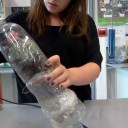Mesocosm Lab
 Setting up sealed mesocosms to try to establish sustainability.
Setting up sealed mesocosms to try to establish sustainability.
(Practical 5)
The IB are not the first to think of making a mesocosm. Bill Latimer set one up in his living room in 1960 and hasn't watered it since 1973. See the whole story here. There are other places where mesocosms have been developed, like Biosphere II laboratory or the University of Birmingham who are using mesocosm experiments in drought research.
Lesson Description
Guiding Questions
What will these plants, and animals need to be able to survive without holes in the bottle?
How will the oxygen get in?
Activity 1 - Building a mesocosm
There are many ways to build a mesocosm. This is a particularly simple model from just two or three clear plastic bottles. The width of the bottles at the place they are cut is important so they fit together.
We used glue guns for the sticking and spoons / spatulas to get the soil into the middle layer.

See photos of the making of our mesocosms here
Activity 2 - Experiment with your mesocosms
Mesocosms have been used in research to test the effects of herbicides and other pesticides, to evaluate climate change effects and for many other purposes. Aquatic mesocosms seem particularly common.
Using the bottles above it is possible to design a long term investigation.
Here are some ideas.
- Make identical mesocosms and put them in positions with varying conditions,
- Increasing light levels. Is there an optimum light level?
- Increasing temperatures. If there is more condensation - like rain clouds do the plants grow better?
- Movement, tip or shake the bottles to see the effect of water movement.
- Connect a data logger to a mesocosm, or build the mesocosm in the data logger chamber.
- Make a range of mesocosms and change one component as an independent variable.
- Put increasing amounts of plant material in, and record the longevity of the mesocosm
- Add more and more water to each mesocosm, is there a minimum amount needed.
- Add more species of plant, or more species of animals.
- Add some rotting compost to the soil. Watch to see the emergence of fruit flies or the presence of maggots
- Connect the water section to the plant section with string, or a piece of wood.
- Mix seeds with the soil, with different amounts in each bottle.
- Add an increasing amount of sediment / sand into the water.
- Measurement that may be possible
- Test the water for pH or nitrates at the beginning and the end of the experiment.
- Measure the mass of plants at the beginning and end.
- Count the leaves, or the number of animals.
This is an interactive map of mesocosm facilities across the world. Click the flags to find out who is doing mesocosm research in each place.
Activity 3 Further reading
Mesocosm experiments have become a valuable tool to circumvent the shortcomings of correlational studies in ecological research. There is plenty of scope for using this apparently simple middle school science club project idea as a great learning activity in IB Biology. Read more about ecological research using mesocosms, or for more ideas see my page of selected weblinks of mesocosm ideas.
Teachers notes
For $50 you can buy one from Abundant Earth, if you are lucky enough to live in the USA. Ekocentrum in Gothenburg, Sweden, has bottled ecosystems dated 2002 just lying around. The British Ecological Society have a great information booklet on keeping brine shrimps in bottles and there are hundreds of other suggestions around. One idea that particularly caught my attention was keeping Cabbage white butterflies in the lab. Not quite a sealed ecosystem but it would involve trying to establish sustainability.
For further information see these links
Ted Talk about Biosphere 2. https://www.ted.com/talks/jane_poynter_life_in_biosphere_2#t-217263

 IB Docs (2) Team
IB Docs (2) Team





